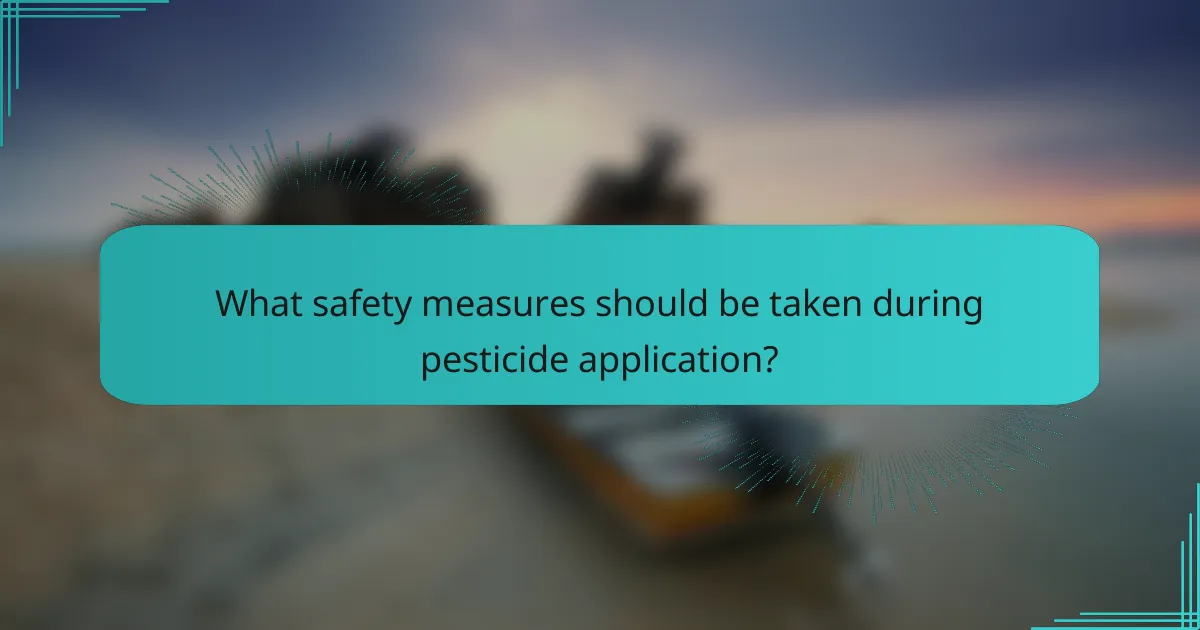Pesticide application techniques are vital for effective pest management, with methods such as ground spraying, aerial application, and fogging each offering unique benefits. To ensure safety for both humans and the environment, it is essential to implement protective measures and choose optimal timing for application, typically during early morning or evening hours. Understanding the right equipment and strategies can significantly enhance the efficacy of pesticide use while minimizing risks.

What are effective pesticide application techniques in Australia?
Effective pesticide application techniques in Australia include ground spraying, aerial application, granular application, fogging, and drip irrigation. Each method has its own advantages and considerations, making it essential to choose the right technique based on the specific situation and target pests.
Ground spraying
Ground spraying involves using equipment like sprayers or boom systems to apply pesticides directly to the target area. This method is often preferred for its precision and control, allowing for targeted application that minimizes drift and waste.
When using ground spraying, consider factors such as wind speed and direction, as these can affect pesticide distribution. It’s advisable to spray during calm weather conditions, typically early morning or late afternoon, to enhance effectiveness and reduce environmental impact.
Aerial application
Aerial application utilizes aircraft to disperse pesticides over large areas, making it suitable for extensive agricultural fields. This technique is efficient for reaching hard-to-access locations and can cover significant ground quickly.
However, aerial application requires careful planning to comply with regulations and ensure safety. Operators must consider factors like wind conditions and the potential for drift, as well as the specific requirements for pesticide registration in Australia.
Granular application
Granular application involves spreading solid pesticide granules on the soil surface or incorporating them into the soil. This method is effective for controlling soil-borne pests and can provide a slow-release effect, reducing the frequency of application.
When applying granular pesticides, ensure even distribution to avoid hotspots that could harm non-target organisms. Timing is crucial; applying before rainfall can help incorporate the granules into the soil, enhancing their effectiveness.
Fogging
Fogging is a technique that creates a fine mist of pesticide, allowing for uniform coverage over large areas. This method is particularly useful for controlling flying insects and is often employed in urban pest management.
For successful fogging, choose the right equipment and ensure that the pesticide formulation is suitable for this application. Fogging should be conducted during low wind conditions to minimize drift and maximize efficacy.
Drip irrigation
Drip irrigation can be combined with pesticide application to deliver chemicals directly to the root zone of plants. This method is efficient in terms of water and pesticide use, reducing runoff and minimizing exposure to non-target organisms.
When using drip irrigation for pesticide application, ensure that the system is properly calibrated to deliver the correct dosage. Regular maintenance of the irrigation system is essential to prevent clogs and ensure consistent application.

What safety measures should be taken during pesticide application?
Implementing safety measures during pesticide application is crucial to protect both human health and the environment. Key precautions include using personal protective equipment, ensuring proper ventilation, and having emergency procedures in place.
Personal protective equipment (PPE)
Wearing appropriate personal protective equipment (PPE) is essential to minimize exposure to pesticides. Common PPE includes gloves, goggles, respirators, and protective clothing. Ensure that the PPE is suitable for the specific pesticide being used, as different chemicals may require different levels of protection.
Before starting the application, check for any signs of wear or damage on your PPE. Replace any damaged items immediately to maintain effective protection. It’s also advisable to follow the manufacturer’s guidelines for the recommended PPE for each pesticide.
Proper ventilation
Ensuring proper ventilation during pesticide application helps to disperse harmful fumes and reduce inhalation risks. Apply pesticides outdoors whenever possible, or in well-ventilated indoor spaces. Open windows and doors, and use fans to improve air circulation.
When working in enclosed areas, consider using air filtration systems to further reduce airborne contaminants. Regularly monitor air quality to ensure it remains within safe limits during application.
Emergency procedures
Establishing clear emergency procedures is vital for responding to pesticide exposure incidents. Create a plan that includes immediate actions to take in case of skin contact, inhalation, or ingestion of pesticides. Ensure that all personnel are familiar with these procedures.
Keep emergency contact numbers readily available, including local poison control and medical facilities. Additionally, have first aid kits stocked with necessary supplies, and ensure that they are easily accessible during pesticide application.

When is the best time to apply pesticides in Australia?
The best time to apply pesticides in Australia is typically early in the morning or during the evening. These times help minimize evaporation and drift, ensuring better absorption and effectiveness of the chemicals used.
Early morning application
Applying pesticides in the early morning can be advantageous due to cooler temperatures and higher humidity levels. These conditions reduce evaporation rates, allowing the pesticide to remain effective on the target area for longer periods.
Additionally, early morning applications can help avoid peak wind conditions, which often occur later in the day. This minimizes the risk of drift and ensures that the pesticide remains where it is intended.
Evening application
Evening applications can also be effective, particularly when temperatures begin to drop. Similar to early morning, the cooler evening air helps reduce evaporation and allows for better absorption of the pesticide.
However, it is crucial to ensure that the pesticide has sufficient time to dry before nighttime dew sets in. If applied too late, moisture can wash away the pesticide, reducing its effectiveness.
Weather considerations
Weather plays a significant role in determining the best time for pesticide application. Wind speed, temperature, and humidity can all affect how well pesticides perform. Ideally, applications should be made when wind speeds are low, generally below 10 km/h, to minimize drift.
Furthermore, avoid applying pesticides before rain is forecasted, as this can lead to runoff and decreased effectiveness. Monitoring local weather conditions can help ensure optimal application timing.

What equipment is essential for pesticide application?
Essential equipment for pesticide application includes sprayers, protective gear, and calibration tools. These items ensure effective and safe pesticide use while minimizing risks to both the applicator and the environment.
Sprayers
Sprayers are crucial for distributing pesticides evenly across the target area. They come in various types, such as backpack, hand-held, and tractor-mounted sprayers, each suited for different scales of application. Selecting the right sprayer depends on the size of the area to be treated and the type of pesticide being used.
When using sprayers, consider factors like nozzle type and spray pattern, as these can significantly affect coverage and efficacy. Regular maintenance is also vital to ensure that the equipment functions correctly and delivers the intended dosage.
Protective gear
Protective gear is essential for safeguarding the applicator from potential pesticide exposure. This includes gloves, goggles, masks, and coveralls, which should be chosen based on the specific chemicals being used. Always refer to the pesticide label for recommended protective equipment.
Wearing the appropriate protective gear minimizes health risks and complies with safety regulations. Regularly inspect gear for wear and tear, and replace items as necessary to maintain optimal protection.
Calibration tools
Calibration tools are necessary to ensure that sprayers deliver the correct amount of pesticide. This process involves adjusting the sprayer settings based on the manufacturer’s specifications and the specific application requirements. Proper calibration helps prevent over-application or under-application, both of which can lead to ineffective pest control or environmental harm.
Common calibration methods include measuring the output of the sprayer over a set time and adjusting the pressure or speed accordingly. Regular calibration checks should be part of the maintenance routine to ensure consistent performance and compliance with safety standards.

How to choose the right pesticide application method?
Selecting the appropriate pesticide application method involves considering factors such as the type of pest, the pesticide formulation, and environmental conditions. Effective methods can enhance efficacy while minimizing risks to human health and the environment.
Safety measures for pesticide application
Safety measures are crucial when applying pesticides to protect both the applicator and the surrounding environment. Always wear personal protective equipment (PPE) such as gloves, masks, and goggles to prevent exposure. Additionally, ensure that the application area is clear of people and pets.
Follow the manufacturer’s instructions regarding safe distances from water sources and sensitive areas. It’s also advisable to check local regulations regarding pesticide use, as some areas may have specific restrictions or guidelines.
Timing strategies for pesticide application
Timing is essential for effective pesticide application. Apply pesticides during calm weather conditions to reduce drift and ensure that the product reaches the target area. Early morning or late afternoon is often ideal, as temperatures are cooler and wind speeds are typically lower.
Consider the life cycle of the pest when planning your application. For example, targeting pests during their active feeding stages can enhance effectiveness. Monitoring pest populations can help determine the best timing for intervention.
Equipment use for pesticide application
Choosing the right equipment is vital for effective pesticide application. Options include sprayers, granulators, and foggers, each suited for different types of pesticides and application scenarios. Ensure that your equipment is calibrated correctly to apply the right amount of pesticide.
Regular maintenance of equipment is necessary to prevent malfunctions and ensure even distribution. Always clean equipment after use to avoid contamination and maintain its longevity. Familiarize yourself with the specific requirements of the pesticide being used, as some may require specialized application techniques.


